#bogeymen
Text




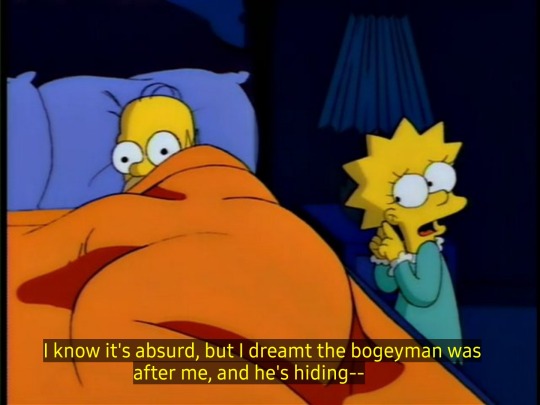



759 notes
·
View notes
Text

#discworld#gnu terry pratchett#meme#discworld meme#created by yours truly#death#hogfather#susan sto helit#bogeymen#sidewalk bear#monsters
77 notes
·
View notes
Note
Could you tell us more about the boogeyman camel?
Why of course! The camel with a sack or baeer bu kharitah (بعير بو خريطة) is described in detail in Al Musallam (2017) Emirati Superstitious Creatures, and I am eternally thankful for an ABC reader for providing that source!
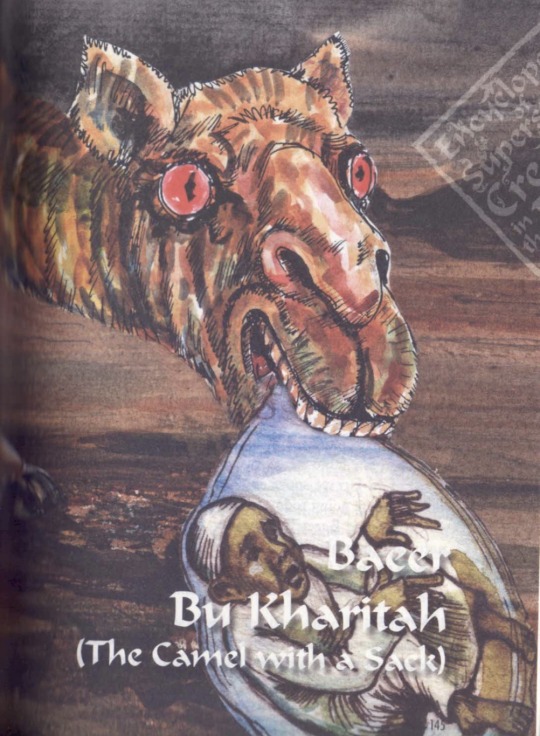
The camel with a sack appears during siesta time and catches Emirati children who are foolishly playing outside at that time. It traps them in its sack, either white (saliva) or red (the fleshy sack that camels extrude).
It carries the children around and releases them somewhere else after a period of time. They can be heard crying inside the sack at night. When they are released, it is often far away, and they forget their parents, so they cannot return home and they never stop crying.
The best way to escape it is to climb to the top of a palm tree, but then you face the problem of getting back down.
#camels#folklore#bogeys#bogeymen#united arab emirates#emirati superstitious creatures#baeer bu kharitah#camel with a sack
112 notes
·
View notes
Text
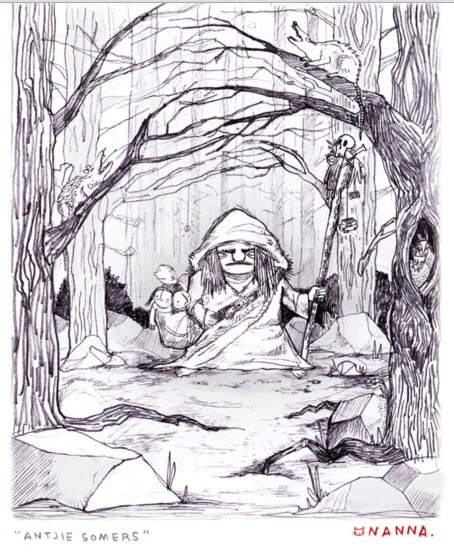
Antjie Somers [South African folklore]
Bogeymen are one of the most common recurring character types among folktales: an evil monster, ghost or undead human that comes out at night and takes misbehaving children. Sometimes to eat them and sometimes just dragging them off to an unknown (yet likely unpleasant) fate. In South Africa, children were told similar tales about Antjie Somers, a local folk character originating from the 19th century. Though she checks all the boxes of a typical bogeyman character, there is one thing that sets her apart from the others: Antjie Somers is human with no clear supernatural traits.
As the story goes, there once was a man named Andries Somers. He worked on a fishing vessel (interesting note: in some variations, he was a slave rather than a conventional fisherman) and was known for his exceptional work ethic: when Andries hauled in his nets, his skill and strength put his fellow fishermen to shame. Aside from being talented and diligent, Andries was also brave and kind-hearted, as he had saved people from drowning on several occasions.
Alas, his diligence bred jealousy in his comrades until one day they decided to teach him a lesson. The fishermen banded together and surrounded Andries on a beach, intending to rough him up. But Andries was a man of exceptional strength and knocked all of his assailants to the ground. When the dust settled however, he saw that one of his attackers couldn’t get up: the man had hit his head falling down and died on the spot. Knowing that he would be charged with murder if he stayed, Andries saw no choice to flee.
He stole a kopdoek (a kind of headscarf) and a dress from his sister and ran away disguised as a woman. After fleeing far away, he eventually found new work in a settlement somewhere over the mountains, where his former comrades would never find him. Andries worked in a vineyard and it wasn’t long until his employer noticed his exceptional work ethic and put him in charge of the other workers. But here his sad past repeated itself, and he soon found himself the target of jealousy and anger from his co-workers. Eventually, they found the dress and kopdoek Andries still kept in his hut, and mocked him endlessly about it. They called him Antjie (a feminine name) and poked fun of him for crossdressing. He endured these childish taunts for three days, before packing his stuff and leaving under the cover of night, full of anger and disappointment.
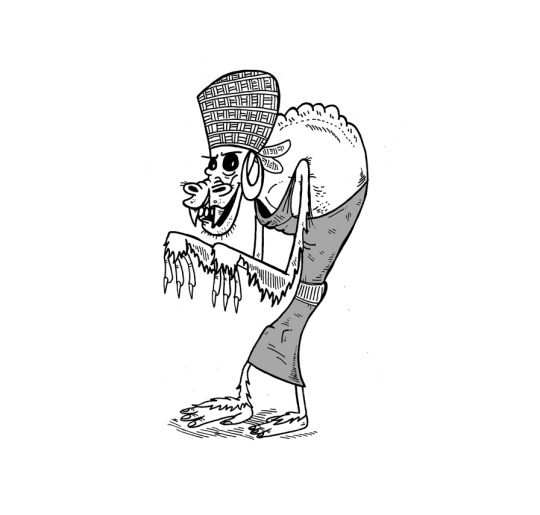
Andries was never found, but after a while, children who had been sent to the forest to collect lumber started telling stories of a strange elderly woman dressed in a striped dress and kopdoek, wearing a sack over her shoulder. The woman was always angry and would threaten kids with her knife, threatening to kill them and stuff their corpses into her sack. Their parents connected the dots and assumed this mysterious woman to be Antjie Somers, as they had taken to calling Andries. From then on, people would warn their kids to behave, lest Antjie Somers stab them and take them away in her sack.
This story actually has some political context, as it originated in a period of tension between workers and farmers following the then-recent abolishment of the slave trade. I won’t go into the details here, but there is quite a bit of historical context to this tale if you want to read up about it.
Though Antjie/Andries is the protagonist of the story, this character was later demonized further and turned into a demonic monster, a goblin, a monstrous woman with animal-like characteristics or a witch in some retellings. In this last version, Andries quite literally became a woman when he turned evil, which also has some political subtext. In fact, because the character was crossdressing and gender-nonconforming, Antjie Somers is sometimes regarded as a queer character, though I assume this is more of a modern interpretation (he only donned the dress to disguise himself, after all). The moral of the story however remains quite simple: don’t leave children unattended in creepy woods.
Sources:
Steenekamp, M., 2011, Antjie/Andries Somers: Decoding the bodily inscriptions of a South African folklore character, research report submitted to the University of the Witwatersrand in fulfilment of the requirements of the Master’s degree of Arts, Johannesburg, South Africa.
Croeser, C., 2020, A wilting whisper of Antjie Somers: a meditation on the witchery and gender-non-conformance of Afrikaans Folklore Figure Antjie Somers, Scrutiny2, 25(2).
Gorelik, B., 2021, Cross-dresser as a bogey: on the gender ambiguity of Antjie Somers in South African folklore, South African Journal of Cultural History, 35(1).
(image source 1: Anja Venter)
(image source 2: Galago on Deviantart)
46 notes
·
View notes
Photo





Art dump of a bunch of DF related doodles and sketches I made on the kitfoxgames discord
one focusing on what kobolds get to have in their caves with befriending anyone with the poisonous animal class and not the mammal animal class.
#dwarf fortress#kitfox games#bogeymen#Angels#kobolds#snakes#tangle the lemur#modded Dwarf fortress#fanart#dwarf fortress spoilers
28 notes
·
View notes
Photo

A bogeyman’s half-life is shortened a tiny bit every time that bogeyman’s name is invoked. Eventually the bogeyman becomes a tired cliché and often can devolve into a farce.
Red-baiting Sen. Joseph McCarthy’s obsessive hunt for alleged communists gradually became a joke about things such as looking for communists under beds.
The more often Republicans use woke now, the sooner it will degenerate into self-parody. So if Republicans can be baited into blaming everything on woke this year, it will sound boring and ridiculous to everybody outside the MAGAsphere by mid 2024.
#war on woke#bogeymen#woke#republicans#gop excuses#donald trump#ron desantis#mike pence#kevin mccarthy#ruben bolling
17 notes
·
View notes
Text
2022 Reading Log, pt 29
My life has been tough lately, so I do what makes me happy. Read books about monsters.

141. The Old Snatchengrabber’s Big Book of Child Eating Monsters by Mike Rosen. This is not beloved British children’s author Mike Rosen, or asshole Republican pundit Mike Rosen. This is a different one. This book is a collection of folkloric bogeymen, illustrated in a cartoony style. Most of these are European, but some from around the world do appear. Some liberties have been taken with the monsters at hand, mostly in the art—the yara-ma-wa-yho, for example, is an amorphous blob instead of a hairless monkey-frog, and Krampus is both female and thicc. Brief, but pleasant.
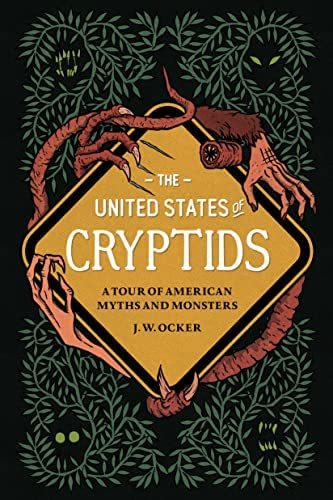
142. The United States of Cryptids by J. W. Ocker. I’ve quite enjoyed Ocker’s Season of the Witch and Cursed Objects, and I quite enjoyed this book as well. The book is as much about crypto-tourism as it is about actual cryptozoology. As such, it takes a pretty broad view of what a cryptid is, including various UFOlogical entities, as well as folkloric entities like the wendigo or Navajo shapeshifters, if they have places to visit or sell merchandise for. It’s also pretty respectful, acknowledging that those aforementioned Navajo shapeshifters, for example, are taboo to a lot of Navajo people still. Ocker has clearly done his homework, and acknowledges that creatures like the Ozark Howler are modern hoaxes, as well as suggesting some very obscure monsters that are ripe for becoming tourist attractions (such as the Derry Fairy, the Prime Hook Swamp Creature and the Kodiak Dinosaur).
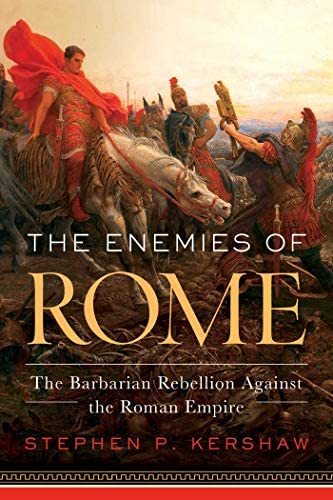
143. The Enemies of Rome by Stephen Kershaw. In some ways, this is the best whirlwind tour of Roman history I could imagine, covering events from the mythical foundation of Rome to the last of the Western emperors. It is most interested in what the Romans thought of the various people they fought and usually defeated, and how Romans built their own identity as separate from “barbarian”, even though they themselves were barbarians from the point of view of Greek culture, which they wholeheartedly appropriated. A lot of time is spent in the late Republic era, which I appreciated. Too often, books about Rome written for a popular audience skip straight from the Punic Wars to Julius Caesar. One thing I didn’t like, however, was its constant use of modern neologisms. “Fake news”, for example, shows up more than five times before I stopped counting. It was cute once, but rapidly became irritating.

144. Flying Snakes and Griffin Claws by Adrienne Mayor. This is a collection of short articles written for various magazines and websites by Mayor, collected and occasionally updated. Most of them are on the subject of weird ephemera of the classical world, often times animal themed. Examples include several articles on tourism in Greece during Roman times, a history of Roman perfumes, the use of weasels as household mousers in the Classical world, and of course writings on Greek and Roman monsters. The book includes her original article proposing that the griffin is based on Protoceratops fossils, and the argument is pretty much just “I went looking for a real animal that looks like a griffin, because I couldn’t imagine that it was a symbolic hybrid, and this is what I found”. In the foreword, she refers to that essay as “embarrassing”, although whether because she has repudiated that (very poorly supported) hypothesis or merely because of its fannish tone addressed to Jack Horner, remains unsaid. I can’t say I recommend this book, but I didn’t consider reading it a complete waste of time.

145. Eaters of the Dead by Kevin J Wetmore Jr. If I could describe this book in one word, it would be “sloppy”. It is a survey of folklore and mythology related to cannibals and man-eating monsters. It seems, at least at first, to be arguing for a hypothesis that all cannibal monsters are embodiments of fears of survival cannibalism, but seems to give up on that thesis half way through. Possibly because the author realizes it’s a non-starter. For example, he claims that ghouls represent a fear of survival cannibalism in the Arabian Desert, before revealing that modern authors consider the corpse-eating and grave-robbing aspect of ghouls to be a Western appropriation in gothic literature, as opposed to an authentic folkloric belief. It also pairs some ideas in very odd ways and acts as if they make sense, like discussing both feeding the dead to vultures (as the Zoroastrians and Tibetans do) and Polyphemus in the Odyssey in the same chapter. It also seems weird to write a book about man-eating monsters, spend an entire chapter on ghouls, but dismiss zombies in two paragraphs. There’s some interesting ideas in here, and some good sources, but I think I would rather read those sources than this book (and in some cases, I have!).
#reading log#monster books#cannibalism#folklore#roman history#classical history#glassical greece#bogeymen#cryptid#cryptozoology
10 notes
·
View notes
Text


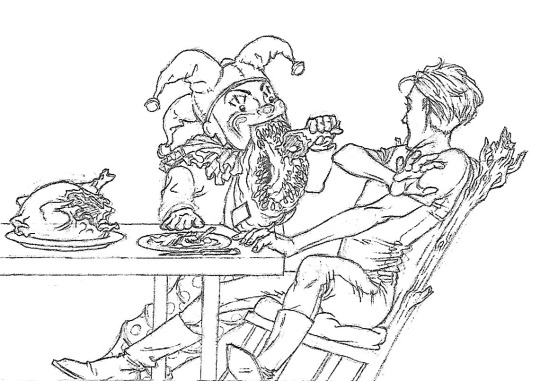
In Angela Carter fashion, a more adult take on Beauty & the Beast. In this case, the handsome son of a corrupt businessman takes his father's place as prisoner to Krampus. During his stay, Adonis von Zeigler realizes his attraction to his beastly captive and even makes some funny friends along the way.
6 notes
·
View notes
Text
Sometimes, I think of the special love we reserve for our terrors. The unique sort of affection that we hold for our horrors, our monsters, our bogeymen. I wonder if we care because of how innocent the nature of these devils are- Mindless, clawing things that speak of the naive sort of fear we had as children- Before our demons wore the skin of men, of wealth, of paper, they were beasts. Alien, eternal and unknown, and beneath fang and talon, a promise of the ethereal strange.
#cryptids#bogeymen#bogeyman#monsters#nightmares#folklore#terrors#horrors#the monsters under my bed were sometimes my only company#the emptiness they left behind echoes a weariness i can’t place#and a sort of grief that cannot ever belong to the absence of men
0 notes
Quote
A place where bogeymen were real, ghosts could talk to you if you listened closely, and black magic could catch you if you weren’t careful.
Shannon Mayer, Midlife Bounty Hunter (Forty Proof, #1)
0 notes
Text

#discworld#gnu terry pratchett#meme#discworld meme#created by yours truly#death#hogfather#susan sto helit#the tooth fairy#tooth fairy#bogeymen#the bogeyman#spongebob
21 notes
·
View notes
Text
Some memes + art from a project I’ve been calling “Nim”:
Context isn’t totally necessary, but the cliff notes are that story is set in an urban fantasy world, Nim and Lune are adopted siblings / father and daughter. They are part of a rarely-seen species who live isolated from the rest of the world and have immense magical power, but left their home in search of a better life shortly before being captured by local mad scientist Sammy. Nim was taken in by Delilah and her shapeshifting dragon son Dante after she was rescued separately from Lune.

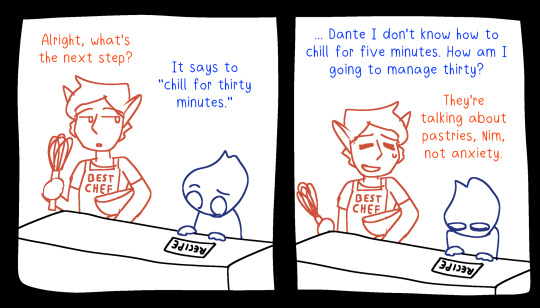



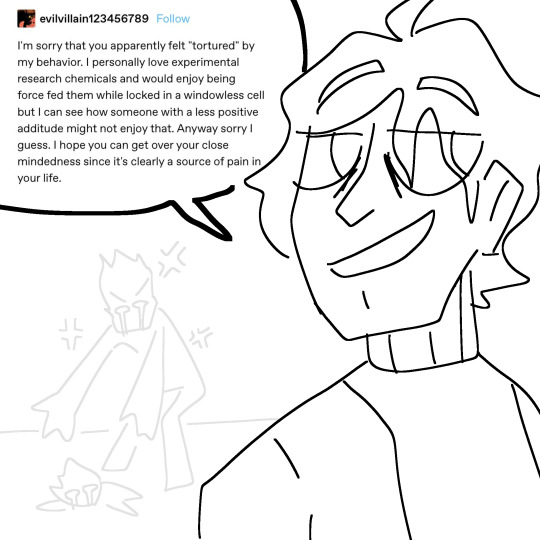

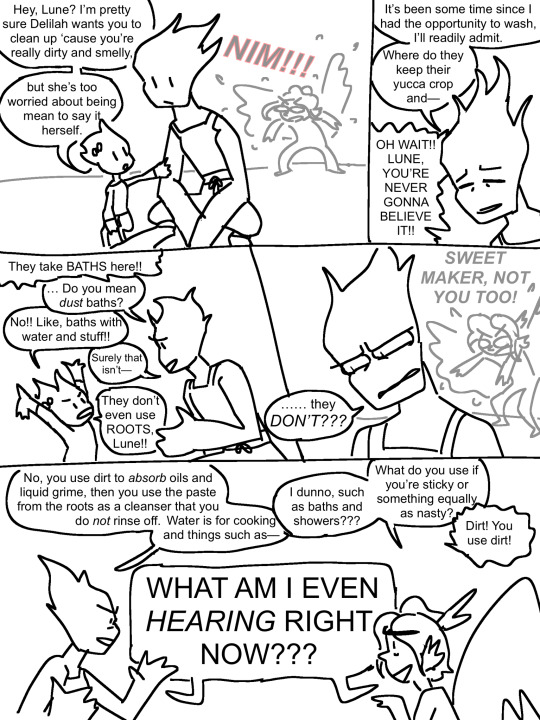
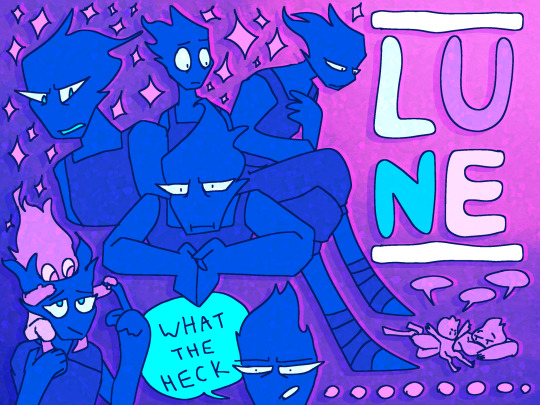
#fun fact: this takes place in that ‘world set in the sketchbook of a teenage girl’ concept idea I posted about#Nim and Lune are what’s known as ‘inklings’—#they’re made up out of the same material as the universe is!#(ink and charcoal and other such stuff)#an inkling is made when graphite smudges#or when a pen blots ink on the page#they are made of imperfection and are seen as dangerous because of their refusal to abide by the maker’s laws#they’re pretty chill people who just want to be left alone most of the time#but your average sketchbook citizen is absolutely TERRIFIED of inklings and see them as bogeymen#stuff by sofie#original character#original character design#original character drawing#original character art#the cartooniverse#art dump
14 notes
·
View notes
Photo

The Tuutarjuit [Inuit mythology]
The Inuit people have a traditional children’s game involving a piece of string or rope. This unassuming pastime is actually a really old game and involves two players trying to make figures with the string between their fingers, trying to make the figures faster than their opponent.
For reasons that aren’t entirely clear to me, the string game was once said to prevent the sun from rising at dawn. If too many people played the game, the sun would be hindered, therefore the game was banned in some locations. Another reason the ancient Inuit people prohibited kids from playing the game was to prevent young children from toying with harpoon lines and getting their fingers stuck, which might result in a kid getting dragged into the icy water.
Additionally, there is a dark folktale associated with the string figure game: the Tuutarjuit were mysterious and malicious spirits of the arctic. Though they were known to attack women, they were also the spirits of the string game: it was said that if kids played string games late at night instead of sleeping, they might draw the attention of a Tuutarjuk, also called a Tuutannguirjuk or Tuutannguaq. Note that the name ‘Tuutannguirjuk’ is derived from the game, as a tuutannguirjuk is also the term for one of the figures the player has to form with the string.
Anyway, when this happens, the spirit will challenge the child to a game. If the spirit loses the string game, it will accept its loss and disappear. If the Tuutarjuk wins, however, it will kidnap the child and take it away, never to be seen again. It is not known what these spirits do to their victims, but nobody has ever seen one of them again.
The Tuutarjuit are exceptionally skilled at the string figure game and have even been known to rip open their own chest and tear out their own intestines to use as strings. One story tells of a naughty boy who was told to go to sleep, but instead he disobeyed his parents and practiced making string figures. Late at night, a Tuutarjuk appeared and noticed that the boy’s family was sound asleep, meaning the spirit could do whatever it wanted. It challenged the child to a game and quickly arose victorious. The monster lunged at his prey, preparing to take the child away when one of the child’s family members awoke. Not wanting to find out what the man would do to a kidnapper, the spirit fled at once.
Sources:
Vandendriessche, E., 2015, String Figures as Mathematics? An Anthropological Approach to String Figure Making in Oral Tradition Societies, Springer, 392pp.
Christopher, N., 2013, The Hidden: a compendium of arctic giants, dwarves, gnomes, trolls, faeries, and other strange beings from Inuit oral history.
(image source: two people playing the string game, stonecut by Agnes Nanogak)
110 notes
·
View notes
Text
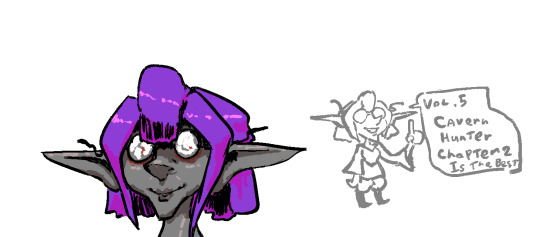



art dump, so the first and fourth picture is just me thinking about dwarf fortress goblins and the vivid hair colors they tend to get.
the second picture is of the same bogeyman who I figured out how to get to hold picks to mine, the eyeless but with feathered antenna look tend to be fun to doodle, the third picture is just a random sketch of a bearded mech pilot... that doesn't show that it's a mech pilot and just someone wearing a cap.
4 notes
·
View notes
Note
The Harker Records also reminds me that Mina's strong desire both at the beginning and the end of the book was to travel with Jonathan to other countries, to learn about the culture, meet the people, see the nature... So they don't have to be bound to London either!
Late night train rides can be as liminal as car ones too (<- has overnight train travelled from Sweden to arctic Norway and Finland) if you want to have inspo for the train times too
The Harkers: “We’re finally going to travel as a couple for fun rather than supernaturally perilous reasons!”
Assorted supernatural jerks across numerous countries: 👁️👁️
#@ assorted monsters and bogeymen please let them have a nice belated honeymoon they deserve it :c#my writing
9 notes
·
View notes